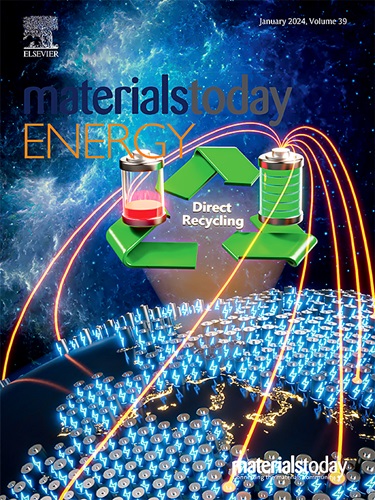Defect and dopant complex mediated high power factor in transparent selenium-doped copper iodide thin films
IF 8.6
2区 材料科学
Q1 CHEMISTRY, PHYSICAL
引用次数: 0
Abstract
Copper iodide (CuI) is a promising -type transparent thermoelectric material for near-room temperature energy harvesting. We report a high-power factor for selenium (Se)-doped CuI films. Ion beam-sputtered CuI films were doped using 30 keV Se implantation with Se concentration varying between 0.50% and 6.50%. Hall effect measurements showed a ∼34% increase in electrical conductivity (σ ≈ 36.1 Ωcm) due to a ∼54% increase in carrier density (p ≈ 5.4 × 10 cm) in the -type γ-CuI film implanted with 5.0 × 10 Se.cm. A high Seebeck coefficient, α ≈ 388.9 μVK, and moderate electrical conductivity, σ ≈ 29.1 Ωcm, yield a nearly 85% increase in the power factor, ασ ≈ 439.7 μWmK, for a 1.0 × 10 Se.cm implanted film compared to the unimplanted film (ασ ≈ 236.4 μWmK). Monte Carlo simulation and density functional theory calculations revealed that the increased displacement per atom values and the {Se−} defect complex-induced shallow acceptor could be attributed to the observed increase in hole density. Our results highlight that native defects and defect complexes are beneficial for enhancing the power factor in transparent CuI for thermoelectric applications.掺硒透明碘化铜薄膜中缺陷和掺杂复合物介导的高功率因数
碘化铜(CuI)是一种很有前途的近室温能量收集透明热电材料。我们报告了硒(Se)掺杂 CuI 薄膜的高功率因数。采用 30 keV 的硒植入法掺杂离子束溅射的 CuI 薄膜,硒的浓度在 0.50% 至 6.50% 之间。霍尔效应测量结果表明,在植入 5.0 × 10 Se.cm 的 γ-CuI 薄膜中,由于载流子密度(p ≈ 5.4 × 10 cm)增加了 ∼54% ,电导率(σ ≈ 36.1 Ωcm)增加了 ∼34%。与未植入的薄膜(ασ ≈ 236.4 μWmK)相比,植入 1.0 × 10 Se.cm 的薄膜具有较高的塞贝克系数(α ≈ 388.9 μVK)和适中的导电率(σ ≈ 29.1 Ωcm),功率因数(ασ ≈ 439.7 μWmK)提高了近 85%。蒙特卡罗模拟和密度泛函理论计算表明,每原子位移值的增加和{Se-}缺陷复合物诱导的浅受体可能是导致所观察到的空穴密度增加的原因。我们的研究结果突出表明,原生缺陷和缺陷复合物有利于提高透明 CuI 在热电应用中的功率因数。
本文章由计算机程序翻译,如有差异,请以英文原文为准。
求助全文
约1分钟内获得全文
求助全文
来源期刊

Materials Today Energy
Materials Science-Materials Science (miscellaneous)
CiteScore
15.10
自引率
7.50%
发文量
291
审稿时长
15 days
期刊介绍:
Materials Today Energy is a multi-disciplinary, rapid-publication journal focused on all aspects of materials for energy.
Materials Today Energy provides a forum for the discussion of high quality research that is helping define the inclusive, growing field of energy materials.
Part of the Materials Today family, Materials Today Energy offers authors rigorous peer review, rapid decisions, and high visibility. The editors welcome comprehensive articles, short communications and reviews on both theoretical and experimental work in relation to energy harvesting, conversion, storage and distribution, on topics including but not limited to:
-Solar energy conversion
-Hydrogen generation
-Photocatalysis
-Thermoelectric materials and devices
-Materials for nuclear energy applications
-Materials for Energy Storage
-Environment protection
-Sustainable and green materials
 求助内容:
求助内容: 应助结果提醒方式:
应助结果提醒方式:


